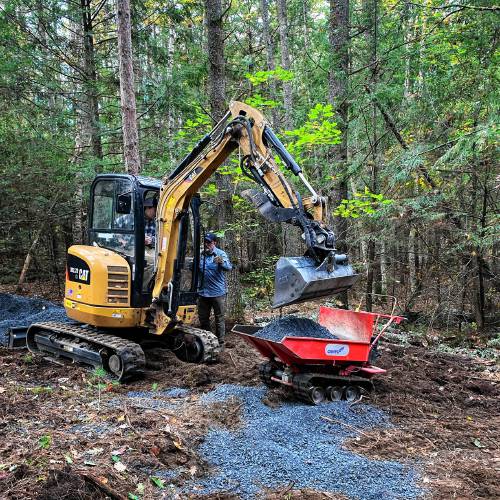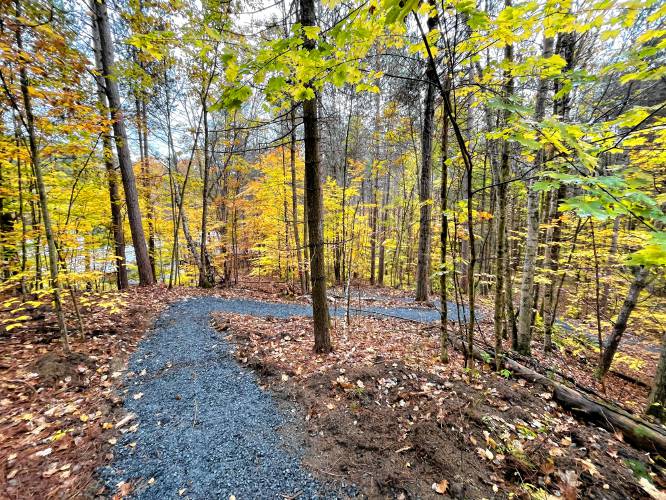
Story Produced by Valley News, a Member of

FAIRLEE, VT – Angela Ricker loved the sunshine and watching the trees move.
While she delighted in the time she spent outdoors, it wasn’t always easy for her family to make it happen. Before her death at age 11 in 2015, Angela used a walker or wheelchair due to Trisomy 13, a rare chromosomal disorder.
“I didn’t know of that many places that we could go with her wheelchair,” said her mother, Melinda Ricker, who with her husband has three other children. “Our family has always been a big hiking family. It was hard to have to leave that part of our lives behind and not even be able to offer it our other children as much as we would have liked to.”
That was something that was on Maggie Stoudnour’s mind, too. When she met Angela in 2015 at Samuel Morey Elementary School in Fairlee, Stoudnour was the coordinator for the Rivendell Trail School Programs, where she planned activities around the Cross Rivendell Trail. Her son, Griffin Stoudnour, now nearly 13, has muscular dystrophy, which limits his mobility.
“I was aware as I was planning field trips … that my son could not come on all the trips,” Stoudnour said.
After meeting Angela, the unfairness of it struck Stoudnour even more. Kids who couldn’t go on the trips either had to stay behind at school or stayed home.
“I think she was, in some ways, where I solidified in my mind that I was going to solve this problem,” Stoudnour said of Angela.
Stoudnour was determined to do something, and her position working with the CRT — she also serves on the board — presented a clear opportunity.
Still, building an accessible trail, especially in a hilly area in the woods, was quite complicated and expensive.
“It was years of thinking about it and kind of percolating before I took any steps,” said Stoudnour, who also serves on the board of the Cross Rivendell Trail.
“A lot of work around figuring out what the requirements are for an (Americans with Disabilities Act) trail and if we could even do it.”
Those steps came to fruition last fall when Angela’s Trail — a 1-mile portion of the Cross Rivendell Trail — opened near Rivendell Academy in Orford. The majority of the roughly $40,000 cost was covered by a grant from the New Hampshire Recreational Trails Program, but the Cross Rivendell Trail still needs to raise around $5,000 to put the finishing touches on the project. The money will go toward installing benches along the trail and adding signs, among other small projects.
To make it accessible, the trail had to be completely reworked in places. Switchbacks were added to better navigate steeper portions.
“That’s kind of what makes Angela’s Trail unique,” said Colin Stemper, owner of Palisade Projects, who oversaw the construction.
“It goes through terrain that’s not typical of an ADA trail from what I’ve seen. It’s densely forested; there’s a creek crossing.”

Construction started in October and ended in December. To meet standards, the majority of the trail has to be 3 feet wide and had to meet strict grade requirements.
“Every hundred feet of distance, you’re only rising 5 feet,” Stemper explained.
Portions of the trail made with sandy soil needed to be filled with hardpack. Trees needed to be cut down. Railings were added to a bridge that crosses a creek.
“Because of where the existing trail was, it wasn’t even clear if we could do it at first,” Stemper said, noting that it was the first time he’d worked on an ADA trail. “It took a bit of creativity to get a trail that met all the requirements.”
Stemper and the CRT board were aided by multiple volunteers and the Upper Valley Trails Alliance, which served as consultants. Over the past decade, the nonprofit has helped other organizations make trails more accessible, including the Vermont Institute Natural Science and the Montshire Museum of Science, said executive director Russell Hirschler.
“It’s a lot of work and it’s not cheap to do, but it’s necessary,” Hirschler said. “Because of the nature of how you have to build accessible trails, you typically need lots of materials to bring in. You need a hardened surface, so oftentimes they’re built close to be able to get machines in to move those materials around.”
What makes Angela’s Trail different from other accessible trails in the Upper Valley like the Mascoma River Greenway, for example, is how far out in nature it is. There is desire in the trails community to build more accessible trails — Stoudnour herself has talked about adding more to the CRT — but there are two big barriers: finding a place to put one and then pulling together the funding.
“There’s not as many dedicated resources in terms of financial resources, grant funds and so forth, to fund these types of accessible trails,” Hirschler said. “You’re generally trying to find flatter areas with fewer changing slopes. In the Upper Valley, you don’t have a lot of that. You have a lot of rolling hills. It’s not easy to find those locations.”
People who struggle with mobility want to be outside, Stoudnour and Ricker stressed. Griffin, Stoudnour’s son, is among them. He loves to swim in lakes in the summer, adaptive downhill skiing in the winter and “going for walks with my family in the woods,” Griffin wrote in an email.
He has tried out Angela’s Trail and finds it easy to use.
“I want (people) to know that they are people like everyone else and that they love going out and enjoying nature like everyone else does, but it can be hard if there are no trails they can go on,” Griffin wrote.
That’s something the community is hoping Angela’s Trail can help change: They’ve shown it is possible with sufficient resources and determination.
“The other thing about accessibility that I think about is it seems like a lot of work for a small number of people, but it’s amazing how transformative it can be for those people, and what a big change it makes in their lives and a relatively small change in other people’s lives,” Ricker said. “I’m thrilled that the trail got built and I hope that people can come out and enjoy it. And make them think about the quality of life in the members of our community who love the outdoors just as much as we do, but have trouble getting there.”
Editor’s note: For more information about Angela’s Trail, visit facebook.com/rivendelltrail.
 These articles are being shared by partners in The Granite State News Collaborative. For more information visit collaborativenh.org.
These articles are being shared by partners in The Granite State News Collaborative. For more information visit collaborativenh.org.







